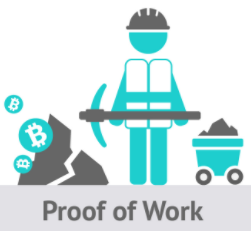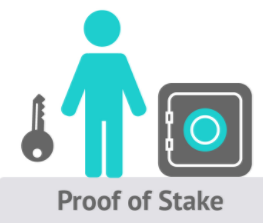Crypto 101- Proof of Whaa!? - Write up

There are many different consensus protocols that you’ve probably heard of, maybe tried to understand and felt overwhelmed by. The terms PoW, Pos, DPoS, and PoA can be super confusing if not explained well. It’s also the backbone of crypto and to fully understand a project you need to understand the ground work.

Proof of Work(PoW):
A proof-of-work (POW) system is as the name states the validation of the work that has happened and proving it is correct. Bitcoin and many altcoins use this form of consensus to make sure the authenticity of the chain is good and that everyone agrees on the transactions that have occurred.
Let me break it down to an example I found online. Pretend you are in a math exam in school with other students.
The first student that can come up with the correct answer, and show the work they did to get that answer, will get rewarded. This requires brain power and a lot of effort on the side of the student.
So now applying that to the crypto world, the math exam is the transaction, the classroom refers to the blockchain network, the student is the computer or node, the brain power is the computing power, and the reference to a lot of effort needed refers to the need for electricity.
Some downsides to POW:
- Requires more electricity which can make mining expensive and more often than not inefficient.
- The hardware that will make mining profitable is an expensive investment.
- Possibility of miners moving their mining power to another coin/blockchain if the rewards are higher, and we have seen this happen with bitcoin forks.
- With the circulating amount of coins increasing, miner’s rewards would start to decrease creating less incentives for them to stay on that blockchain.
- A 51% attack. As mentioned in my blockchain 101 video. Meaning if someone has 51% of the mining power on the network, they have the ability to manipulate the blockchain.

Proof of Stake(PoS):
Nodes on the network don’t spend time and electricity to solve a mathematical problem to reach a consensus; instead, they place a bet on blocks. When a block is added to the chain, whoever had placed a bet on it, gets rewarded. A proof of stake system requires the prover to show ownership of a certain amount of money or stake, and it’s age to participate in the bet.
In the proof of stake system, blocks are said to be “minted”, not mined. Users who validate transactions and create new blocks in this system are referred to as nodes. Those individuals receive transaction fees as rewards for keeping their crypto in its designated walletIn order to validate transactions and create blocks, a node must first put their own coins at ‘stake’.
Think of this as their holdings being held in an escrow account, meaning their crypto is being held by a third-party on behalf of transacting parties. In the PoS system if a node validates a fraudulent transaction, they lose their holdings, as well as their rights to participate as a forger in the future. Meaning they are incentivized to validate the correct transactions and protect the network.
So it's sort of like storing money in a savings account or savings bond. You commit coins to staking, and you get a chance to get paid what can essentially be described as interest on your coins.
Unlike bitcoin where in order to attack the network you would need to get 51% of the mining power, with PoS you would have to own 51% of all the circulating coins on the network to physically overtake it. There is no need for expensive mining hardware, for PoS you jut need to keep your computer running, and the wallet open and running.
Because of that, PoS requires significantly less energy than PoW does. And the transactions are extremely fast.
Some downsides to POS:
- The same reason the PoS algorithm is good is also its downside, in the simplest explanation: the more “stake” you hold, the more rewards you receive - so, the rich get richer.
- Another issues is PoS inherently makes people want to hold and stake their coins instead of trading or using them as currency.
- Although this helps to strengthen and stabilize the network, eventually coins with a cap to their circulating supply will be difficult or expensive to obtain.
Two types of POS rewards:
Randomized block selection:
Some coins like PIVX, use randomization to predict the next reward receiver, this makes staking more balanced

Coin age based selection:
The coin age based system selects the next node based on the ‘coin age’ of the stake.
Coin age is calculated by multiplying the number of days the cryptocurrency coins have been held as stake by the number of coins that are being staked. Most projects have set staking requirements, for example the coins have to mature after x amount of blocks, or you have to hold them for x amount of days.
Once a user has minted a block, their coin age is reset to zero and then they’ll have to wait a certain length of time before they are eligible to be a minting node again.
DPoS (Delegated Proof of Stake):
The DPoS method was first implemented by the Bitshares blockchain, but can now be seen on other platforms such as Lisk and ARK. The difference between a regular PoS system and a DPoS system can be compared to the difference between direct democracy and representative democracy. In regular proof of stake every wallet which contains coins is able to ‘stake’ – In a Delegated Proof of Stake system every wallet which contains coins is able to vote for delegates.
These delegates perform the function of validating transactions and maintaining the blockchain and take the transaction fees as profit - this process is called “forging” or “minting”. The delegates will then share a potion of that profit with those who have voted for them.
For us in the United States, this is similar to how we receive representation in congress based on votes in each state. We have also seen the negative side of that. The view on DPoS is that it is more efficient than the PoS consensus system because the wallet does not always have to be on, and open.
Also DPoS may be more profitable and have less entry level hurdles because you can join pools, whereas with most traditional PoS systems you need a large quanity of hte crypto to make staking worth it. DPoS gives owners with smaller, to medium sized holdings a chance to actually benefit from the system.

Downsides to DPoS
- The argument is by concentrating the role of validation in a smaller number of hands, it is less decentralized and can backfire.
- It also suffers from the same problem which any democratic system suffers from: voters not being engaged and the system not working from lack of community involvement.
- If most regular users fail to vote then there may be a tendency for the network to be controlled by large stakeholders who can simply vote for themselves.
- Or, as mentioned again in my Lisk video, voter groups can create monopolies and require votes for their entire groups, such as Elite, or else the voting individuals don’t get paid.
PoA (Proof of Activity)
A lesser known consensus system is PoA which is used by Decred, which I recently covered.
This approach that takes bits from the Proof of Work and Proof of Stake systems. Their goal with this was to create a balance between miners and normal users. PoW miners are needed to generate the blocks that build the blockchain and PoS miners are needed to ensure that PoW miners create blocks that are consistent with the desires of the users of the currency.

Downsides:
- Decred is the only project using this consensus system as of right now, so mass scaling to bitcoin level transactions have yet to be tested, meaning speed and cost could still be a concern.
- Criticisms I've read of proof of activity are the same as for both proof of work (too much energy is required to mine blocks) and proof of stake (there is nothing to deter a validator from double signing) - causing people to feel like PoA may have too many moving parts to be successful.
There are obviously pros and cons to each consensus system. PoW is already at the point where the average person cannot participate in strengthening the network because its too expensive, and there are no incentives. I personally think that randomized PoS is the only truly fair way to maintain the strength of a network, while still incentivising the average person to stake coins, and prevent serious disparities in rewards allowing those with the biggest holdings to obtain more.
Sources:
PoW vs PoS
PoS
Consensus Protocols
Join my discord!
Follow me:
Patreon
My other vlog
Twitter
Steemit
Instagram
Cryptex Discord
Website
If you're feeling generous- Tip Jars:
ETH: 0x3b97C664a9DAf6c79d6d577E0048a412BaAe68dE
BTC: 1K2Qjrf5KUxMpLqfmXLWJxwBnPzayoiGGL
Bitcoincash: 1ECdtoqg3RcWkt4JY9bb1BrvBpLsm7h3ho
LTC: LhimSAApQPY68EzXzLU1YVw4hndLfjEcXw
VTC: Vi7Bf9cGTDT2Fy55wAHeXxEKbq1EFScWg5
LSK: 7023499790024781333L
PIVX: DMBX1QdEwVsi3DVmftEvFFjd7MGV6Xfnma
BLOCK: Bi1MrzBb5EkXQckNFgXtYAw1aDHNkKvRTs
DASH: XrvCsw51nkm9Me8iwtMCyKWUrmNXFe6DMf
ADA: DdzFFzCqrht4t5pJS75mBtw7iDthAqw5gxhys1tRBt7EbTNaPLjpRpru4Zbqz3RcZXbwvz6kHXHH1EFb33v2xo3p12TC9jzXrV7B1DZm
DISCLAIMER:
The information provided is not to be considered as a recommendation to buy or invest in certain assets or currencies and is provided solely as an educational and information resource to help traders make their own decisions. Past performance is no guarantee of future success.
It is important to note that no system or methodology has ever been developed that can guarantee profits or ensure freedom from losses. No representation or implication is being made that using the attached material will guarantee profits or ensures freedom from losses.
CryptoCandor shall not be liable to the participant for any damages, claims, expenses or losses of any kind (whether direct or indirect) suffered by the participant arising from or in connection with the information obtained this website or directly from the website owner.

Very nice write up, very clear explanation. I would have mentioned NEO Gas because it is very popular and so easy to collect.
Thank you for sharing such good information. I just wondering that if total supply of bitcoin has reached its limit (21million btc), will PoW btc still exist? or what miners do when it reaches its limit? and if PoW btc wouldn't exist anymore, will the transaction fee of btc going higher?
Thank you, I upvoted your post. It is such a good information for exploring crypto knowledge ti me.
PIVX is a good coin but I think it's better option... POSW = STAKENET.
POSW is in the rebranding process which at the end of the month will have a fork from PIVX.
Adding to PIVX value: Supported by Ledger Nano S, Trussless Proof of stake and it will have a Staking platform service as the old POSW had earlier but much professional and better design... big potential imo.
https://steemit.com/cryptocurrency/@greensmile/posw-stakenet-2018-roadmap
https://steemit.com/cryptocurrency/@greensmile/stakenet-first-cryptocurrency-to-use-trustless-proof-of-stake
So based on your conclusion, is PIVX your favorite coin? What % of your CUM (Crypto Under Mgt) do you have in PIVX? Do we have any proof PIVX would do well in volatile heavy-volume days-- the likes of which slow down bitcoin to a trickle and also cause high mining fees. Perhaps the high cost of masternodes would slow it down bc there wouldn't be enough of them?
Congratulations @brandneweyes! You have completed some achievement on Steemit and have been rewarded with new badge(s) :
Click on any badge to view your own Board of Honor on SteemitBoard.
For more information about SteemitBoard, click here
If you no longer want to receive notifications, reply to this comment with the word
STOPThe OCD Team discovered this gem of a post!
Reply to this comment if you accept, and are willing to let us share your gem of a post! By accepting this, you have a chance to receive extra rewards and one of your photos in this article may be used in our compilation post! You can follow @OCD – learn more about the project and see other Gems! We strive for transparency.
If you would like to be resteemed by @ocd and reach a bigger audience, use the tag ocd-resteem. Three posts using this tag will be chosen each day by our curators to be RS. Good Luck!
@OCD now has a witness, feel free to vote for @ocd-witness if you want to help support other undervalued authors!
accept